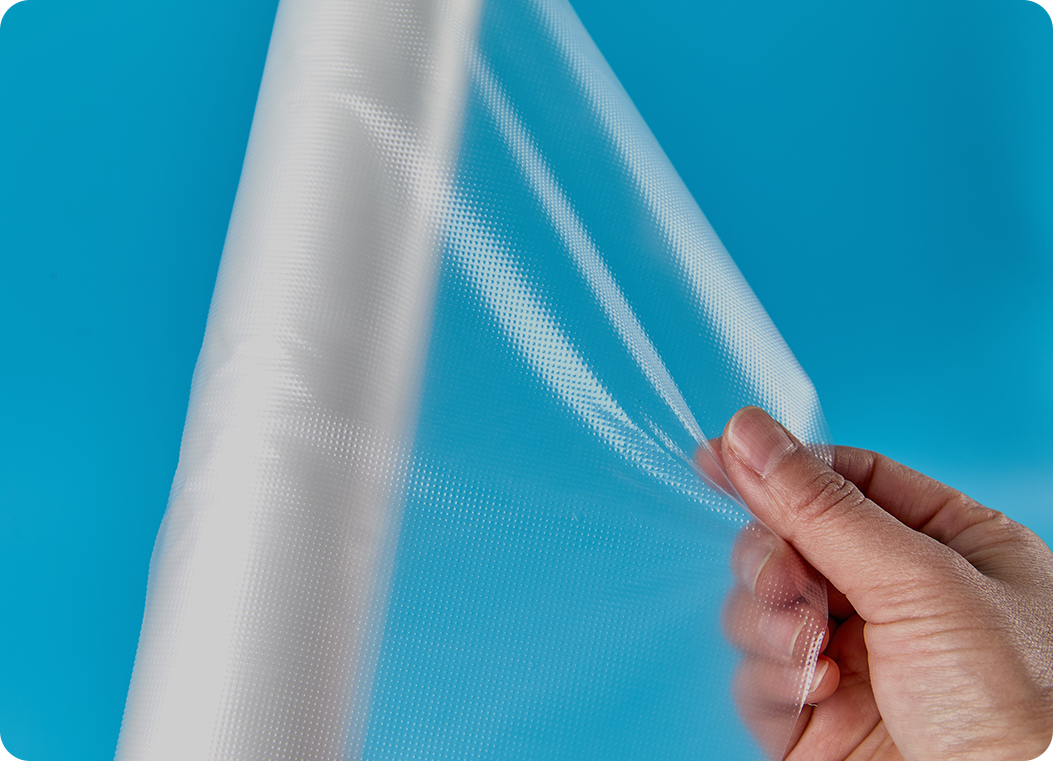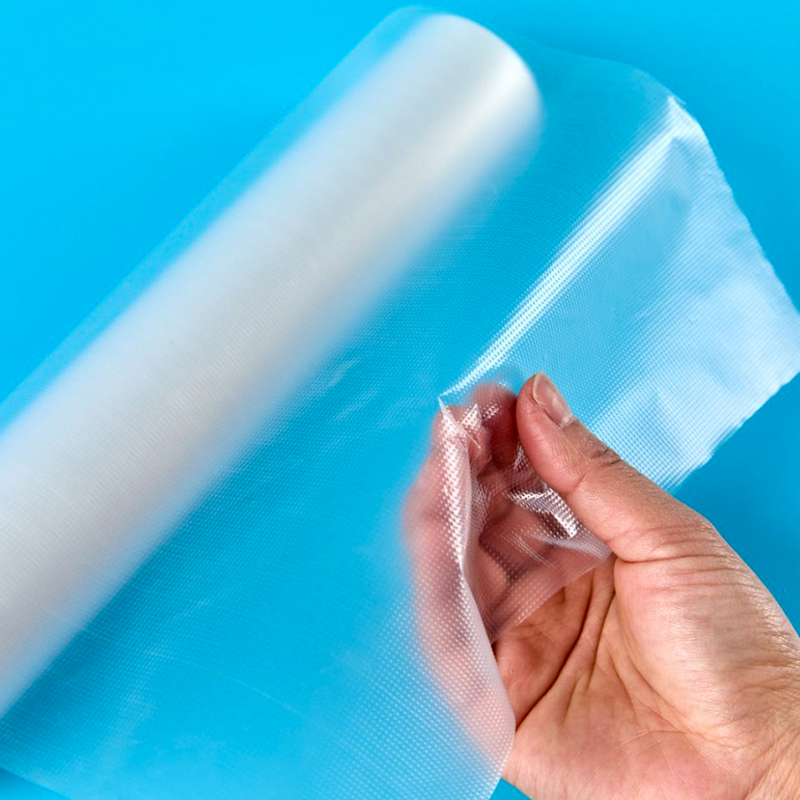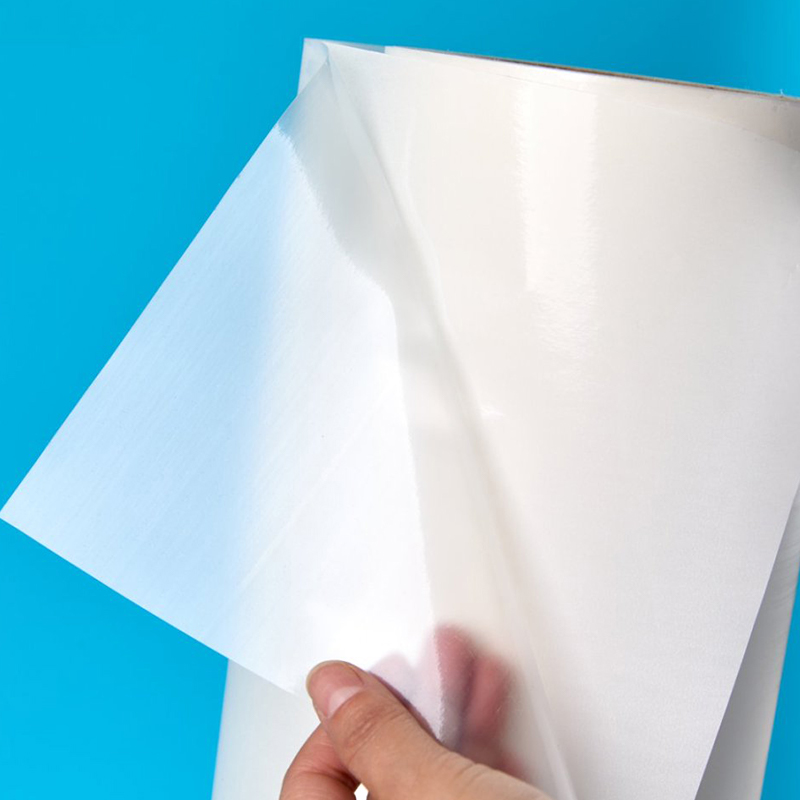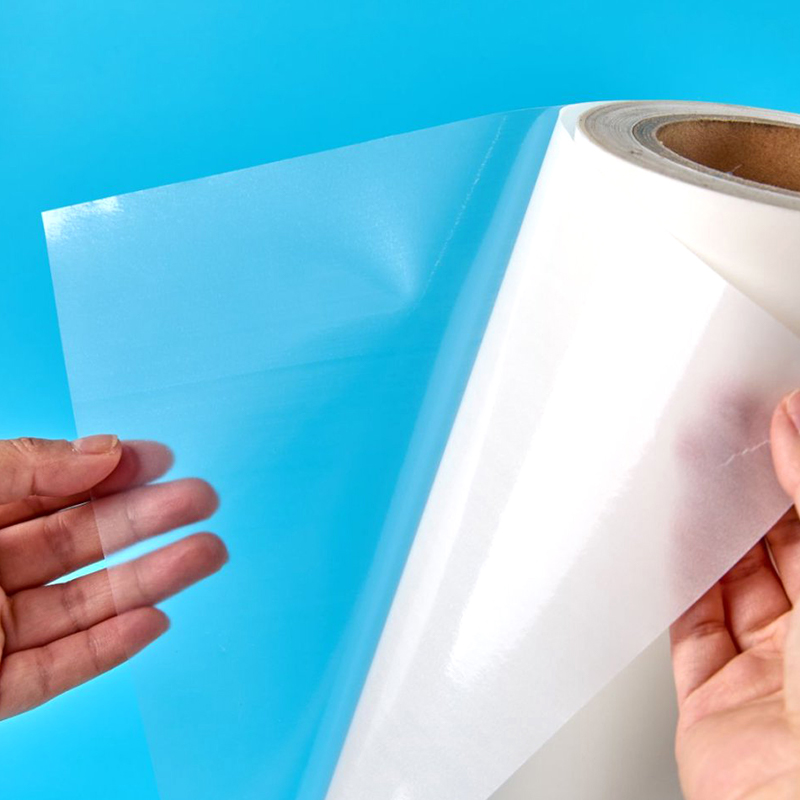What is embroidered hot melt adhesive film?
Embroidered hot melt adhesive film is a special adhesive product that plays a critical role in the field of modern embroidery and fabric processing. Structurally, it is usually a thin film material made of high molecular polymers through special processing. It has a special chemical structure and can form a strong chemical bond or physical entanglement with the fiber molecules on the surface of the fabric under certain temperature and pressure conditions. It can be closely combined with embroidery threads, decorative pieces and other embroidery-related materials. These films have excellent flexibility and will not affect the original soft feel and drape of the fabric after lamination. Its washability is very excellent. After multiple washing and dry cleaning, it can still maintain good adhesion, ensuring that the embroidery pattern is firmly attached to the fabric for a long time. Embroidered hot melt adhesive film also has good weather resistance. Whether in a hot environment or in a cold environment, it can maintain stable performance and ensure the quality and appearance of embroidery products.
Purpose and Application
The main purpose of embroidered hot melt adhesive film is to provide a reliable and efficient fixing and bonding method for embroidery technology, solving many problems existing in traditional embroidery, such as easy detachment of embroidery thread, difficulty in accurately positioning patterns, and easy damage to fabrics.
Clothing customization and fashion industry: In high-end clothing customization, designers often use embroidered hot melt adhesive film to fix complex and exquisite embroidery patterns, such as the exquisite embroidery on some hand-made custom dresses and high-end suits. Through the effect of adhesive film, embroidery and fabrics can be perfectly combined to enhance the overall quality and artistic sense of clothing. In fast fashion brands, embroidered hot melt adhesive film is also used to achieve rapid and accurate pasting of embroidery patterns in large-scale production, improve production efficiency and reduce costs.
Home textile products: In the field of home textiles, whether it is decorative embroidery on bedding or exquisite patterns on curtains and sofa covers, embroidered hot melt adhesive film plays an important role. It can make embroidery firmly attached to home textile fabrics, withstand the test of friction and washing in daily use, and remain beautiful and durable.
Home decorations: Embroidery on home decorations such as wall hangings and carpets can achieve diversified designs with the help of embroidered hot melt adhesive film, enriching the decorative effect of the home space, while ensuring that the embroidery will not fall off or be damaged during long-term use.
Industrial and labor protection products: Logos and protective patterns on some industrial fabrics and labor protection clothing can be fixed with embroidered hot melt adhesive film to ensure that the embroidery part remains firm in harsh working environments and plays its due role in identification and protection.
Why it is favored in the modern environment
In today's fast-developing modern environment, this hot melt adhesive film is favored for its many outstanding advantages.
Efficient production: Compared with the cumbersome needle fixation methods in traditional embroidery technology, the use of embroidered hot melt adhesive film shortens the production time. In large-scale production, the embroidery fixation can be completed quickly by simply attaching the adhesive film with the embroidery pattern to the fabric at the right temperature and pressure, which significantly improves production efficiency.
Precise positioning and realization of complex designs: embroidered hot melt adhesive film can accurately position the embroidery pattern on the fabric. For some complex and delicate embroidery designs, such as floral patterns with tiny details, delicate geometric figures, etc., traditional processes may find it difficult to ensure the accuracy and consistency of the pattern, while the adhesive film can easily achieve it, allowing the designer's creativity to be perfectly presented.
Fabric protection: In the traditional embroidery process, frequent needle punctures may cause a certain degree of damage to the fabric, affecting the strength and appearance of the fabric. The hot melt adhesive film adopts a laminating method to avoid physical puncture of the fabric and protect the original performance of the fabric to the greatest extent. It is especially suitable for some high-end and fragile fabric materials.
Environmental protection and sustainability: Modern society has increasingly higher requirements for environmental protection. Many embroidered hot melt adhesive films are made of environmentally friendly polymer materials, which have less pollution to the environment during production and use. Its efficient bonding method reduces resource waste and conforms to the concept of sustainable development.
Main features of embroidered hot melt adhesive film
The embroidered hot melt adhesive film has been carefully developed and designed, and has a series of unique features to meet the use requirements in different scenarios.
Strong adhesion performance: Under appropriate temperature and pressure conditions, the embroidered hot melt adhesive film can form strong adhesion with various fabric materials, such as cotton, linen, silk, chemical fiber, etc., as well as embroidery thread, decorative sequins, etc. This adhesion can not only ensure the firmness of embroidery in daily wear and use, but also withstand the test of multiple washing and friction, ensuring that the embroidery pattern remains intact and beautiful for a long time.
Good flexibility and bending resistance: After lamination, the film will not make the fabric stiff, but still maintain good flexibility, making the clothing or fabric products comfortable to wear. After multiple bending and stretching, the adhesion between the film and the fabric and embroidery will not be significantly affected, avoiding problems such as degumming and embroidery falling off caused by bending.
Strong weather resistance: Whether it is hot summer or cold winter, the embroidered hot melt adhesive film can maintain stable performance. In high temperature environment, the film will not soften and flow to cause the embroidery to shift; in low temperature environment, it will not become brittle and lose adhesion, ensuring the quality and service life of embroidery products under different climatic conditions.
High transparency: Most hot melt adhesive films have the characteristics of high transparency. After lamination, they will hardly affect the color and gloss of the embroidery pattern, and can maximize the exquisite effect of embroidery, so that the embroidery and fabric are perfectly integrated, presenting a natural and beautiful appearance.
Easy to operate: The process of using embroidered hot melt adhesive film is relatively simple, and it can be operated with only basic heating and pressure equipment, such as hot presses. During the production process, operators can quickly grasp the parameters such as temperature, pressure and time of lamination, improve production efficiency, and reduce the difficulty and cost of operation.
Diverse options: There are many types of hot melt adhesive films on the market to choose from. According to different fabric materials, embroidery process requirements and usage scenarios, there are adhesive film products with different melting points, adhesive strengths and thicknesses. For light and thin silk fabrics, adhesive films with lower melting points and thinner thicknesses can be selected; for heavy denim, adhesive films with stronger adhesion and higher melting points can be selected to meet diverse needs.
Why embroidered hot melt adhesive film is better than traditional embroidery fixing methods
Compared with traditional embroidery fixing methods, upgrading to embroidered hot melt adhesive film has many significant advantages.
Greatly improved production efficiency: Traditional embroidery fixing methods, such as hand-sewing to fix embroidery patterns, require a lot of time and manpower, and are extremely inefficient. Even if a sewing machine is used for fixing, when facing complex patterns, it is necessary to frequently change the needle method and adjust the stitches, which is cumbersome to operate. However, embroidered hot melt adhesive film only needs to fit the film with the carrier with embroidery under certain conditions to quickly complete the fixation, which can increase the production efficiency by several times or even dozens of times, shorten the production cycle of the product, and improve the market competitiveness of the enterprise.
Cost reduction: Although embroidered hot melt adhesive film itself has a certain cost, from the perspective of the overall production process, it greatly improves production efficiency and reduces labor costs and time costs. Reduce the defective rate caused by improper operation of traditional processes, and the comprehensive cost is effectively controlled. In large-scale clothing production, the use of embroidered hot melt adhesive film can reduce a large number of manual embroidery hours and reduce production costs.
Better embroidery effect: Traditional fixing methods may cause problems such as unevenness and deformation of embroidery patterns due to the density of stitches and differences in needle methods. The embroidered hot melt adhesive film can provide uniform adhesion, so that the embroidery pattern is flat and firmly attached to the fabric, which can better show the details and exquisiteness of the embroidery and improve the quality and grade of the product.
Wider scope of application: Traditional embroidery fixing methods may be difficult to implement on some special fabrics, or the effect is not good. The embroidered hot melt adhesive film can be applied to almost all common fabric materials, whether it is soft silk or rough canvas, and can achieve good adhesion effect, which broadens the application range of embroidery technology.
More convenient maintenance: Embroidery products fixed with embroidered hot melt adhesive film have more firm embroidery parts during daily washing and maintenance, and are not prone to falling off or deformation, which reduces the need for repair work due to embroidery damage and is convenient for consumers to use and maintain.
Where is embroidered hot melt adhesive film most commonly used?
Due to its unique properties, embroidered hot melt adhesive film has been widely used in multiple industries and scenarios.
Apparel manufacturing: This is one of the most widely used areas for this hot melt adhesive film. From T-shirts and shirts worn daily to fashionable dresses and jackets, to sportswear and work clothes, embroidered hot melt adhesive film is widely used to fix embroidery decorations. On T-shirts, the common design of printed patterns combined with embroidery can be quickly and firmly attached through embroidered hot melt adhesive film; brand logos and functional patterns on sportswear are also ensured to remain intact under high-intensity exercise and frequent washing with the help of adhesive film.
Home textile product production: In home textile products, such as bedding sets, pillows, curtains, etc., embroidered hot melt adhesive film is used to fix various exquisite embroidery patterns, adding beauty and artistic sense to home textile products. The floral and geometric embroidery on bedding will not fall off easily during daily use and washing due to the adhesion of the adhesive film, ensuring the durability of the product.
Leather product processing: On leather clothing, leather bags, leather shoes and other leather products, there are often embroidery decorations to enhance the grade of the product. Embroidered hot melt adhesive film can be well combined with the leather material, firmly fix the embroidery on the leather surface, and will not adversely affect the texture and flexibility of the leather.
Craft production: In the production process of hand-embroidered crafts, embroidered wall paintings, etc., the use of embroidered hot melt adhesive film can better fix the embroidery thread and pattern, prevent the embroidery thread from loosening and the pattern from deforming during the subsequent mounting and display process, and ensure the quality and ornamental value of the crafts.
Car interior decoration: Car seats, interior panels and other parts sometimes use embroidery technology to enhance the beauty and comfort of the interior. Embroidered hot melt adhesive film is used to fix these embroidered decorations so that they can withstand the frequent friction, vibration, temperature and humidity changes in the car interior, and maintain long-term beauty and firmness.
Choosing the right embroidered hot melt adhesive film: What you need to know
Choosing the ideal embroidered hot melt adhesive film requires comprehensive consideration of multiple factors to meet specific application requirements.
1.Evaluate the use environment and fabric material
Indoor and outdoor use: If the embroidery products are mainly used indoors, the weather resistance requirements for the film are relatively low; if used for outdoor products, such as embroidery on outdoor parasols, embroidery decorations on outdoor billboards, etc., you need to choose an embroidered hot melt adhesive film with excellent UV resistance and wind and rain erosion resistance to ensure that it will not debond or age in harsh outdoor environments for a long time.
Differences in fabric materials: For natural fiber fabrics such as cotton and linen, most general- purpose embroidered hot melt adhesive films can be used, but for high-end and sensitive fabrics such as silk and wool, you need to choose a film that has little damage to the fiber, mild viscosity, and can maintain the original texture of the fabric; for chemical fiber fabrics, consider the compatibility of the film with the chemical fiber material and choose a product that can form good adhesion. When embroidering on silk clothing, you can choose a low-melting-point, soft film specially designed for silk; when using it on chemical fiber sportswear, you need to choose a film that has strong bonding with chemical fiber materials and good washability and wear resistance.
2.Determine the required adhesion strength
Small and simple embroidery: For some small and lightweight embroidery patterns, such as delicate small patterns on the collar and cuffs of clothing, a film with medium adhesion strength can generally meet the needs, which can ensure that the embroidery is firm and will not affect the feel of the fabric due to excessive viscosity of the film.
Large and complex or heavy embroidery: If it is a large embroidery pattern, or the embroidery part needs to withstand greater tension and friction, such as large-area embroidery on backpacks and suitcases, and heavy embroidery for identification or protection on industrial fabrics, you need to choose a film with high adhesion strength to ensure that the embroidery will not fall off under various conditions of use.
3.Consider the melting point and fluidity of the film
Melting point selection: The melting point should be selected according to the heating equipment used and the heat resistance of the fabric. If you use an ordinary iron for lamination, you can choose a film with a relatively low melting point for easy operation; if you use a professional ironing machine, you can choose a film with a melting point within an appropriate range according to the temperature control accuracy of the equipment and the material of the fabric. It is necessary to avoid the situation where the film has a too low melting point, which causes premature melting and adhesion during storage or transportation, and to prevent the melting point from being too high and exceeding the temperature range that the equipment can reach, so that a good lamination effect cannot be achieved.
Fluidity: The film has moderate fluidity after melting. Excessive fluidity may cause the glue to overflow the embroidery area during the lamination process, affecting the appearance of the product; insufficient fluidity may not evenly fill the gap between the embroidery and the fabric, resulting in loose adhesion. For fine embroidery patterns, it is necessary to choose a film with relatively weak fluidity and the ability to accurately control the lamination range; for large-area embroidery, a film with slightly better fluidity can be appropriately selected to ensure quick and uniform lamination.
4.Transparency and color of the adhesive film
If the embroidery product needs to maintain the original color and gloss of the embroidery pattern and make it blend naturally with the fabric, a highly transparent embroidered hot melt adhesive film should be selected. This kind of adhesive film is almost invisible after lamination, which can maximize the exquisite effect of embroidery. However, in some special cases, such as adding light-colored embroidery on dark fabrics, in order to enhance the contrast, you can also choose an adhesive film that is similar to the embroidery color or has a certain covering power. However, it should be noted that the color of the film should not be too bright or cause obvious interference to the embroidery color.
5.Installation and operation convenience
Choosing an embroidered hot melt adhesive film that is easy to cut, place and laminate can improve production efficiency and reduce the difficulty of operation. Some adhesive film products have a special backing design, which is convenient for operation during cutting and placement, and it is not easy for the adhesive film to stick or shift; in the laminating process, a film with relatively broad requirements for temperature, pressure and time parameters and easy to master should be selected. Even if the operator is inexperienced, he can quickly get started through simple training to ensure the stability of the laminating quality.
Keep your embroidery hot melt adhesive film in top condition
Embroidered hot melt adhesive film plays an important bonding role in embroidery technology, and its condition directly affects the quality of embroidery products. To keep the embroidered hot melt adhesive film in the best condition, it is necessary to pay attention to multiple links such as storage, use, and transportation. The specific points are as follows:
|
Attention link |
Specific requirements |
|
Storage environment |
Keep in a cool, dry and well ventilated place, avoid direct sunlight and high temperature, and keep away from water and moisture. |
|
Storage |
Stack neatly to avoid squeezing and folding |
|
Preparation before use |
Choose the right size according to the fabric, cut neatly and match the size |
|
Hot pressing parameters |
Adjust temperature, time and pressure according to fabric material |
|
Transportation Requirements |
Prevent violent collision and extrusion, and do a good job of sun protection and moisture protection |
Why HAITA Embroidery Hot Melt Adhesive Film is the right choice for your project
Environmentally friendly and non-toxic: HAITA's embroidered hot melt adhesive film does not contain harmful substances such as formaldehyde. After inspection, it is an environmentally friendly product. There is no dust in its production and use process, and it does not harm the upper respiratory tract of workers. It meets modern environmental protection requirements and is especially suitable for projects with high environmental protection standards such as children's clothing.
Easy to use: The hot melt adhesive film can be peeled off at low temperature and low pressure, and it is easy to tear off without high pressure peeling, and it is easy to operate. It can be directly needled and embroidered, which can effectively maintain the shuttle bed and other parts and extend the life of the machine.
High production efficiency: The use of embroidered hot melt adhesive film can reduce manpower, and the product effect is good, clean and flawless. It is fast-dissolving, odorless, slippery, and has fewer thread breaks. The needle is durable, not easy to break the blunt needle tip, and will not cause the sewing flower to have brakes and rags. It can achieve fast production and fast delivery.
Good bonding effect: It can play a role in embossing and hole grains, which can prevent the cloth from sliding and shifting. At the same time, the degumming is breathable, the degumming is clean and non-sticky. The pores of the film also have a soft cushioning effect on the cloth, which can avoid the phenomenon of yarn slipping, yarn drawing, hand stains and broken bottom line caused by manual tearing of paper. The product is neat and clean, and no residual fibers will be left.
Wide range of applications: HAITA's embroidered hot melt adhesive film is suitable for all surface fabrics and embroidery, which can meet the embroidery needs of various materials and provide solutions for different projects.
Cost saving: Compared with water-soluble materials and processing methods, embroidered hot melt adhesive film is more cost-saving. While ensuring product quality, it helps to reduce project costs and improve economic benefits.





 English
English 中文简体
中文简体 Türk
Türk






